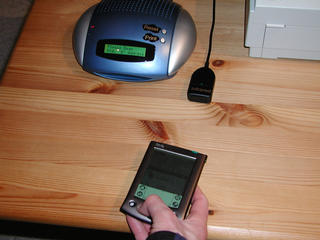Article: Constructing a Linux-powered IrDA printing device
Jun 7, 2002 — by LinuxDevices Staff — from the LinuxDevices Archive — 1 viewsThe idea
Tired of filling out forms? Nobody can read your handwriting? Is your last name 'Rausch', and no one can spell it?
More and more people own a PDA these days, and most of these devices are equipped with an infrared port. Thanks to IrOBEX (PDF download), these devices can even talk to one another and exchange simple records like addresses or calendar entries. But when it comes to the world outside, the only transfer between those PDA's and a target system seems to be a keyboard, at best, and a form and a pencil, at worst.
People have gotten so used to filling in forms by hand, that nobody doubts that process anymore. So, people pull out their PDAs and copy the data from the screen onto a form. But what if you could simply beam the information required, directly from your PDA?
This idea began to dawn on me during a recent trip through Europe, as I noticed that my wife (who was my girlfriend back then) would often pull her Handspring Visor out of her pocket to look up some information, and then write it down onto some piece of paper by hand. This step seemed so unnecessary, that it started me wondering why there aren't any places (to my knowledge) that have installed IrDA transceivers to receive information from a PDA and process it. Wouldn't that be useful at hotels, rental-car agencies, mailing offices, etc. — basically, places where names, addresses, and other such information are required?
At around the same time, we were wrestling with ideas of starting our own business. So I decided to try my hand at implementing a gadget that could receive and process messages from any IrDA/Obex talking device. And that is what gave birth to TxLogic.
TxLogic is a message-handling framework that supports different protocol end-points, one of them being IrOBEX. It allows turning a number of various message filters into one particular application setup.
The prototype
In order to create such a device, I had two main choices: design and build my own electronics, based on a system-on-chip processor or programmable logic device; or simply buy a ready-to-use small system and use it as a prototype. The latter option seemed more feasible, and was a better fit for my restricted budget.
While looking for a hardware box and software platform to put my application onto, the combination of a 3iNET Universal Interface Box (UIB) plus Linux seemed to be a good candidate. The prototype I built consists of the UiB running Linux-2.4. The UiB offers two control buttons and an LCD display for the user interaction part. The modem port is not used in this application. The IrDA interface I settled on is an off-the-shelf ActiSys IrDA transceiver (IR220L+) that connects to the UiB's only serial port.
The Linux implementation is basically a modified linux-2.4 kernel. The userspace programs mainly consist of a collection of Debian utilities. There aren't very many excess tools installed, since the UiB's Flash disk only has room for about 8MB total.
On top of this, I installed my own software, which I intend to keep proprietary since I hope to make a business out of this in the future. Everything on top of the kernel interface — protocols, message parsing and handling, process scheduling, user Interaction — is part of that software, which is what I call “TxLogic”.
Trying it out
After a number of sleepless nights with lots of work, the prototype system (shown below) was ready for testing.

The TxLogic prototype setup
Finally, all I needed was a real-world location where a prototype of my idea could be tested. For that, I selected a Mailboxes Etc. office in Berkeley, CA.
The prototype application allows customers to beam their Sender Address record along with up to 3 recipient address records, and print them onto an official Mail Boxes Etc. mailing form. This test has proven Linux to be a reliable platform for the installation. An online product presentation video, which demonstrates the device's operation, is available here
Future applications
There are numerous applications for this idea. Possilities include: check-in at hotels, car-rental agencies, and airports; providing personal data at health-care providers' offices; calendar synchronization; list transfers; etc.
Basically, wherever a need exists to transfer information between a PDA and another computerized entity, a 'TxLogic device' could be useful.

This article was originally published on LinuxDevices.com and has been donated to the open source community by QuinStreet Inc. Please visit LinuxToday.com for up-to-date news and articles about Linux and open source.